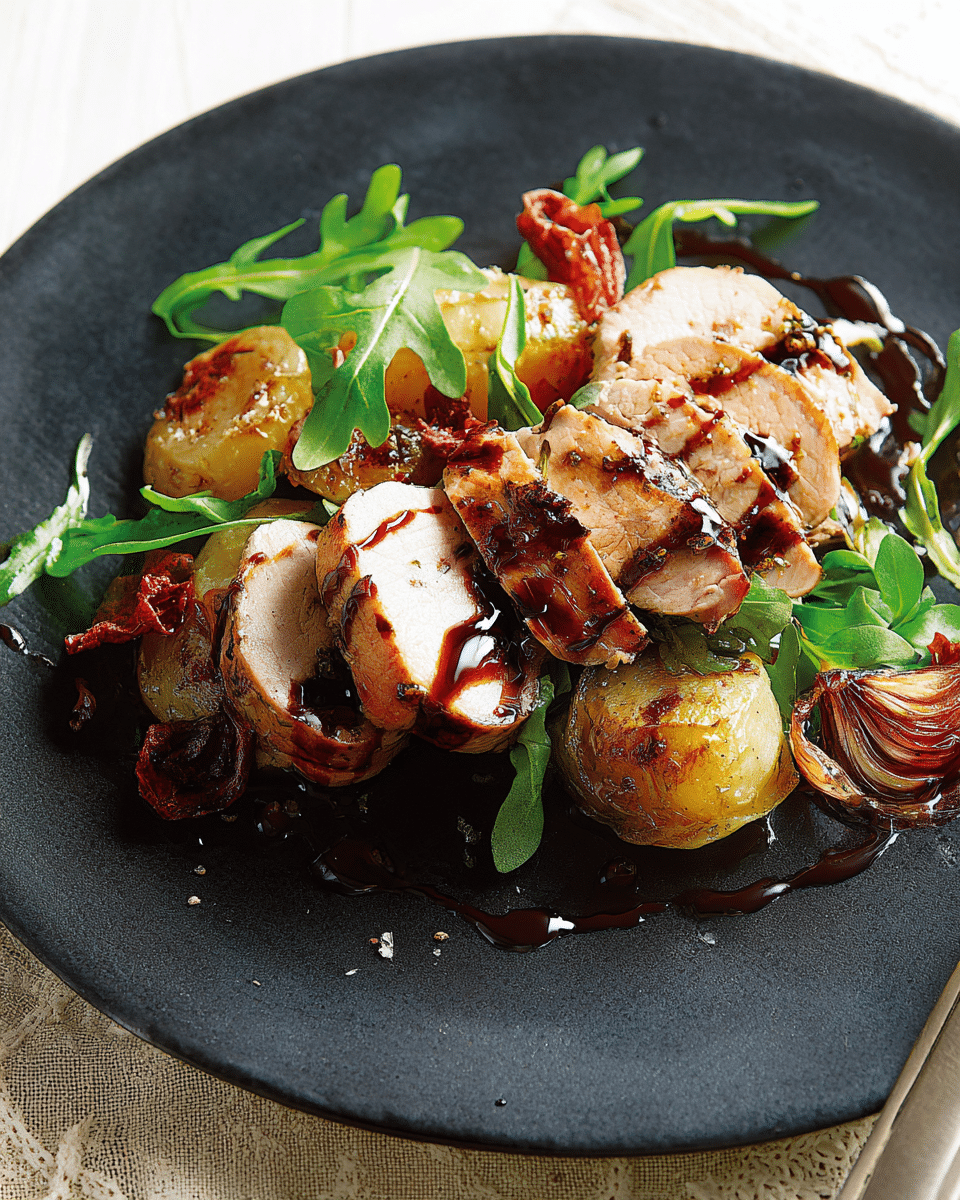The tender pork fillet, perfectly seared to lock in juices, paired with crispy, golden potatoes creates a hearty dish that’s both satisfying and flavorful. The tangy balsamic glaze adds a delicious contrast, tying everything together with its sweet and acidic notes.
This dish is incredibly versatile, making it a great choice for both casual dinners and special occasions. The contrast of textures – from the crunchy potatoes to the tender pork – combined with the rich balsamic sauce, makes for an unforgettable dining experience. Whether you’re cooking for yourself or entertaining guests, this meal is sure to impress.
Full Recipe:
-
2 pork fillets
-
4 large potatoes, peeled and diced
-
2 tablespoons olive oil
-
1 tablespoon fresh thyme leaves
-
2 cloves garlic, minced
-
Salt and pepper to taste
-
1/4 cup balsamic vinegar
-
1 tablespoon honey
-
1 tablespoon Dijon mustard
Directions:
-
Preheat your oven to 400°F (200°C).
-
In a large baking dish, combine the diced potatoes with 1 tablespoon of olive oil, thyme, garlic, salt, and pepper. Toss them to coat and spread them in an even layer.
-
Roast the potatoes for 30-35 minutes, stirring halfway through, until they are golden and crispy.
-
While the potatoes are roasting, heat 1 tablespoon of olive oil in a pan over medium-high heat. Season the pork fillets with salt and pepper.
-
Add the pork fillets to the hot pan and sear each side for 2-3 minutes, until browned.
-
Reduce the heat to medium and continue cooking for another 5-7 minutes, or until the pork reaches your desired level of doneness.
-
While the pork is cooking, in a small saucepan, combine the balsamic vinegar, honey, and Dijon mustard. Bring to a simmer over medium heat and cook for 3-5 minutes until the sauce thickens slightly.
-
Once the pork is done, remove it from the pan and let it rest for a few minutes. Drizzle the balsamic glaze over the pork fillets and serve with roasted potatoes.
Prep Time: 10 minutes | Cooking Time: 40 minutes | Total Time: 50 minutes
Kcal: 380 kcal | Servings: 2 servings
History and Origin
Pork and potatoes have long been beloved staples in many culinary traditions around the world. The origin of pairing pork with potatoes can be traced back to European countries, where both ingredients were abundant and affordable. In particular, the use of balsamic vinegar in cooking has strong roots in Italian cuisine. Originating from Modena, Italy, balsamic vinegar is made from the fermentation of grape must, and it has been used for centuries to enhance the flavors of both sweet and savory dishes.
The concept of balsamic vinegar paired with pork has grown in popularity due to its ability to balance the richness of the meat with its acidic, slightly sweet flavor profile. In fact, this combination can be found in many modern European dishes, from Italy to France. The marriage of roasted potatoes with a glaze of balsamic vinegar has also gained popularity in contemporary cooking, offering a comforting and flavorful contrast to the more delicate notes of the pork.
While this dish is often associated with Italian-inspired flavors, the versatility of balsamic vinegar and the humble potato means that this recipe can be adapted and enjoyed in many parts of the world.
Variations and Adaptations
While the basic version of Pork Fillet with Potatoes and Balsamic Dressing is delicious on its own, there are numerous ways to tweak this recipe to suit your tastes or dietary needs.
-
Vegetarian or Vegan Adaptation: For those who follow a plant-based diet, the pork fillet can be replaced with hearty vegetables like portobello mushrooms or eggplant. Roasted cauliflower also makes a great substitution, providing a satisfying bite and a mild, nutty flavor that complements the balsamic dressing.
-
Flavor Variations: While the balsamic glaze is a key component of this recipe, you can easily switch up the flavor by experimenting with different vinegars. For example, red wine vinegar or apple cider vinegar can provide a tangy punch without the sweetness of balsamic. Adding fresh herbs like rosemary or sage to the glaze will enhance the savory notes of the pork.
-
Potato Variations: The classic roasted potatoes can be swapped out for other types of root vegetables. Sweet potatoes offer a rich, slightly sweet alternative that pairs wonderfully with the balsamic dressing. You could also try adding carrots or parsnips to the dish for a more colorful and diverse plate.
-
Spices and Seasonings: If you prefer a bit of heat, adding chili flakes or a touch of smoked paprika to the balsamic glaze will give the dish an extra layer of flavor. For a more fragrant touch, a dash of garlic powder or ground mustard can make the dish even more aromatic.
Nutritional Information
Pork Fillet with Potatoes and Balsamic Dressing is a well-rounded meal that offers a balance of protein, healthy fats, and carbohydrates. Here’s a breakdown of the dish’s nutritional value per serving (based on 2 servings):
-
Calories: 380 kcal
-
Protein: 30g
-
Carbohydrates: 32g
-
Fat: 18g
-
Fiber: 5g
-
Sugar: 7g (mostly from the balsamic vinegar and potatoes)
The pork fillet is a rich source of protein and essential amino acids, which are crucial for muscle repair and overall body function. Potatoes, on the other hand, provide complex carbohydrates that offer lasting energy, along with a good amount of fiber. The balsamic glaze adds a minimal amount of sugar but is otherwise a low-calorie condiment that enhances the dish without overwhelming it.
In terms of micronutrients, this meal is an excellent source of vitamin C, particularly from the potatoes, which help support the immune system. Additionally, the dish contains a range of B-vitamins from the pork and potatoes, contributing to overall energy production and brain function.
While the dish is balanced, those watching their fat intake may want to reduce the amount of olive oil used in roasting the potatoes, or opt for a leaner cut of pork.
Serving Suggestions and Pairings
Pork Fillet with Potatoes and Balsamic Dressing is a versatile dish that pairs beautifully with a variety of sides and beverages. Here are a few creative ideas to complement this meal:
-
Vegetable Sides: Lightly steamed green beans, roasted Brussels sprouts, or sautéed spinach work wonderfully alongside this dish, adding a burst of color and nutrients. The slight bitterness of Brussels sprouts, in particular, contrasts nicely with the sweetness of the balsamic glaze.
-
Salads: A crisp salad with arugula, feta cheese, and a lemon vinaigrette makes a refreshing and tangy contrast to the richness of the pork and potatoes. You could also serve it with a simple mixed greens salad dressed with olive oil and lemon juice.
-
Bread: A crusty loaf of French bread or a warm, soft dinner roll can help sop up any leftover balsamic glaze, making it an ideal accompaniment to the dish.
-
Wine Pairing: For a wine that complements the dish, try a medium-bodied red wine like Pinot Noir or Merlot. These wines have a subtle earthiness that pairs well with the savory pork and balsamic dressing, while their fruitiness balances the dish’s richness. If you prefer white wine, a dry Riesling or Sauvignon Blanc works equally well.
-
Dessert: For dessert, consider something light and refreshing, such as a lemon sorbet or a fresh fruit salad. These options provide a refreshing finish that won’t overpower the meal’s flavors.
Tips and Tricks for Success
-
Don’t Overcook the Pork: Pork fillets can easily become dry if overcooked. Use a meat thermometer to ensure the internal temperature reaches 145°F (63°C) for optimal juiciness. Let the pork rest for a few minutes before slicing to retain its moisture.
-
Crisp Potatoes: For extra crispy potatoes, make sure they are evenly coated with oil and spaced out on the baking sheet. Crowding the potatoes will cause them to steam instead of roast. If necessary, use two baking sheets.
-
Balsamic Glaze: If you prefer a thicker glaze, reduce the balsamic vinegar mixture for a longer time, stirring frequently to prevent burning. You can also add a pinch of salt or a splash of soy sauce to enhance the depth of flavor.
-
Make Ahead: The potatoes can be prepped ahead of time and stored in the refrigerator until you’re ready to roast them. The balsamic glaze can also be made in advance and stored in an airtight container for up to a week.
Potential Health Benefits
This dish offers several health benefits, especially when enjoyed as part of a balanced diet. The lean protein from the pork fillet helps build muscle and supports tissue repair, while the potatoes provide essential vitamins and minerals, including potassium, which is vital for heart health. Additionally, the balsamic vinegar in the glaze contains antioxidants that may help reduce inflammation in the body.
Advertisement
The use of olive oil, a healthy fat source, contributes to heart health by promoting good cholesterol levels. The balsamic dressing, with its minimal sugar content, also provides a more health-conscious way to add flavor to the dish compared to heavier sauces.
Conclusion
Pork Fillet with Potatoes and Balsamic Dressing is a delightful, versatile dish that combines simple ingredients to create an unforgettable meal. Whether you’re cooking for yourself or entertaining guests, this recipe is sure to impress with its balance of flavors and textures. The tender pork, crispy potatoes, and sweet-tangy balsamic dressing come together in a way that’s both comforting and sophisticated. With endless variations and serving possibilities, it’s a dish that can be enjoyed again and again, no matter the occasion.






